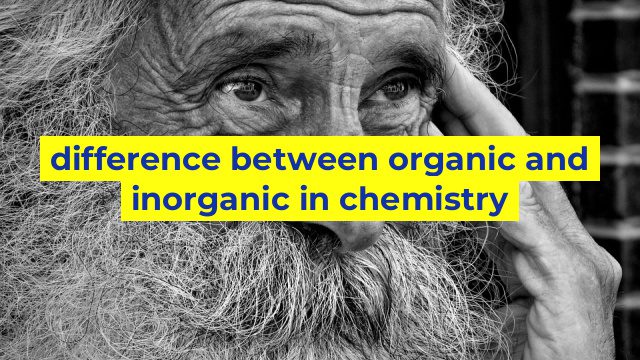The Untold Story: Understanding the Difference Between Organic and Inorganic in Chemistry
What is Organic Chemistry?
Organic chemistry is the study of carbon-containing compounds, which include life molecules such as carbohydrates, lipids, proteins, and nucleic acids. Organic compounds are abundant in nature and have a critical impact on life on Earth. They are responsible for the taste of food, the smell of flowers, the colors of leaves, and the beauty of gemstones.
What is Inorganic Chemistry?
Inorganic chemistry is the study of non-carbon-containing compounds, which include salt, acids, bases, and metals. Inorganic compounds are abundant in the Earth’s crust and do not have a critical impact on the environment. They are used in many industrial processes, and their properties are of crucial importance in fields such as metallurgy, geology, and environmental science.
The Main Differences between Organic and Inorganic Chemistry:
– The chemistry of organic compounds relies on the covalent bonding between carbon atoms, while inorganic compounds contain ionic bonds or coordination bonds.
– Organic compounds have low melting and boiling points, while inorganic compounds have high melting and boiling points.
– Organic compounds are generally soluble in organic solvents, while inorganic compounds are soluble in water and other polar solvents.
– Organic compounds are combustible, while inorganic compounds are not.
– Organic compounds tend to be more complex and diverse than inorganic compounds.
The Importance of Organic Chemistry in Everyday Life
Organic chemistry has a significant impact on our daily lives. It has led to the discovery of new drugs and antibiotics, the development of synthetic materials such as plastics and fibers, and the improvement of food quality and agricultural practices. Organic chemistry has also helped to reduce our dependence on petroleum-based products, to mitigate environmental damage, and to promote sustainable development.
The Role of Inorganic Chemistry in Industry
Inorganic chemistry plays a crucial role in many industries, such as metallurgy, ceramics, semiconductor, and pharmaceuticals. Inorganic compounds are used as catalysts, coatings, pigments, water treatments, and fertilizers. They are also essential in energy-related applications, such as nuclear reactors, fuel cells, and batteries. Inorganic chemistry contributes to the development of new technologies and provides solutions to environmental challenges.
Conclusion
Organic and inorganic chemistry are two critical branches of chemistry that have different applications and properties. Organic chemistry focuses on carbon-containing compounds that play a vital role in life sciences and consumer products. Inorganic chemistry deals with non-carbon-containing compounds that are important in industrial materials, energy, and environment. Understanding the difference between organic and inorganic chemistry can help you appreciate the diversity and complexity of the chemical world.
Table difference between organic and inorganic in chemistry
Organic vs Inorganic Chemistry
| Feature | Organic Chemistry | Inorganic Chemistry |
|---|---|---|
| Definition | The study of compounds containing carbon. | The study of compounds that do not contain carbon (with exception of carbonates, carbides, and cyanides). |
| Bonding | Covalent bonding is the most common type. | Mostly ionic bonding, but also covalent and metallic bonding occur. |
| Properties | Most organic compounds are non-polar, have low melting and boiling points, are flammable, and have low solubility in water. | Inorganic compounds can be polar or non-polar, have high melting and boiling points, are non-flammable, and are often soluble in water. |
| Examples | Alcohols, carbohydrates, lipids, proteins, and nucleic acids. | Acids, bases, salts, metals, and minerals. |
| Occurrence | Organic compounds are found in living organisms, fossil fuels, and other natural sources. | Inorganic compounds are found in rocks, soil, water, and other non-living sources. |

